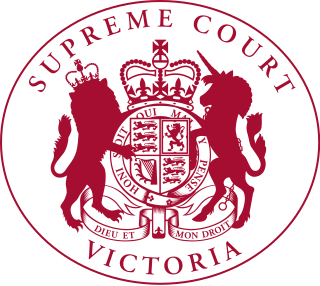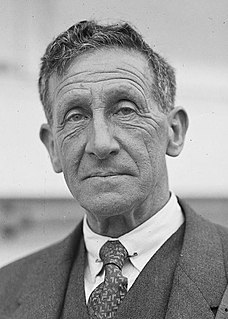Section 51 of the Constitution of Australia grants legislative powers to the Australian (Commonwealth) Parliament only when subject to the constitution. When the six Australian colonies joined together in Federation in 1901, they became the original States and ceded some of their powers to the new Commonwealth Parliament. There are 39 subsections to section 51, each of which describes a "head of power" under which the Parliament has the power to make laws.

Australian constitutional law is the area of the law of Australia relating to the interpretation and application of the Constitution of Australia. Several major doctrines of Australian constitutional law have developed.

Commonwealth v Tasmania was a significant Australian court case, decided in the High Court of Australia on 1 July 1983. The case was a landmark decision in Australian constitutional law, and was a significant moment in the history of conservation in Australia. The case centred on the proposed construction of a hydro-electric dam on the Gordon River in Tasmania, which was supported by the Tasmanian government, but opposed by the Australian federal government and environmental groups.
The law of Australia comprises many levels of codified and uncodified forms of law. These include the Australian Constitution, legislation enacted by the Federal Parliament and the parliaments of the States and territories of Australia, regulations promulgated by the Executive, and the common law of Australia arising from the decisions of judges.
The doctrine of the separation of powers in Australia divides the institutions of government into three branches: legislative, executive and judicial. The legislature makes the laws; the executive put the laws into operation; and the judiciary interprets the laws. The doctrine of the separation of powers is often assumed to be one of the cornerstones of fair government. A strict separation of powers is not always evident in Australia; instead the Australian version of separation of powers combines the basic democratic concepts embedded in the Westminster system, the doctrine of "responsible government" and the United States version of the separation of powers. The issue of separation of powers in Australia has been a contentious one and continues to raise questions about where power lies in the Australian political system.
Section 51(i) of the Australian Constitution enables the Parliament of Australia to make laws about:
Section 51(xx) of the Australian Constitution, is a subsection of Section 51 of the Australian Constitution that gives the Commonwealth Parliament the power to legislate with respect to "foreign corporations, and trading or financial corporations formed within the limits of the Commonwealth". This power has become known as "the corporations power", the extent of which has been the subject of numerous judicial cases.
The reserved powers doctrine was a principle used by the inaugural High Court of Australia in the interpretation of the Constitution of Australia, that emphasised the context of the Constitution, drawing on principles of federalism, what the Court saw as the compact between the newly formed Commonwealth and the former colonies, particularly the compromises that informed the text of the constitution. The doctrine involved a restrictive approach to the interpretation of the specific powers of the Federal Parliament to preserve the powers that were intended to be left to the States. The doctrine was challenged by the new appointments to the Court in 1906 and was ultimately abandoned by the High Court in 1920 in the Engineers' Case, replaced by an approach to interpretation that emphasised the text rather than the context of the Constitution.
Section 51(v) of the Constitution of Australia is a subsection of Section 51 of the Constitution of Australia that gives the Australian Parliament power to legislate on "postal, telegraphic, telephonic, and other like services".
Australian administrative law defines the extent of the powers and responsibilities held by administrative agencies of Australian governments. It is basically a common law system, with an increasing statutory overlay that has shifted its focus toward codified judicial review and to tribunals with extensive jurisdiction.
In Australian constitutional law, Chapter III Courts are courts of law which are a part of the Australian federal judiciary and thus are able to discharge Commonwealth judicial power. They are so named because the prescribed features of these courts are contained in Chapter III of the Australian Constitution.

Re Wakim; Ex parte McNally was a significant case decided in the High Court of Australia on 17 June 1999. The case concerned the constitutional validity of cross-vesting of jurisdiction, in particular, the vesting of state companies law jurisdiction in the Federal Court.

R v Burgess; Ex parte Henry, was a case decided in the High Court of Australia regarding the scope of the trade and commerce power and the external affairs power, in sections 51(i) and 51(xxix) respectively, of the Constitution.

The Constitution of Australia is the supreme law under which the government of the Commonwealth of Australia operates, including its relationship to the States of Australia. It consists of several documents. The most important is the Constitution of the Commonwealth of Australia, which is referred to as the "Constitution" in the remainder of this article. The Constitution was approved in a series of referendums held over 1898–1900 by the people of the Australian colonies, and the approved draft was enacted as a section of the Commonwealth of Australia Constitution Act 1900 (Imp), an Act of the Parliament of the United Kingdom.

New South Wales v Commonwealth, commonly known as the Wheat case, or more recently as the Inter-State Commission case, is a landmark Australian judgment of the High Court made in 1915 regarding judicial separation of power. It was also a leading case on the freedom of interstate trade and commerce that is guaranteed by section 92 of the Constitution.

Farey v Burvett, is an early High Court of Australia case concerning the extent of the defence power of the Commonwealth. The majority of the Court took an expansive view of the defence power in a time of war, holding that the defence power extended to fixing the maximum price for bread. The Court adopted a different approach to the interpretation of the defence power which emphasised the purpose of the legislation, the defence of Australia, rather than the subject matter. As the law fell within a Commonwealth power, whether the law was necessary or appropriate for the defence of Australia was a matter for Parliament.







